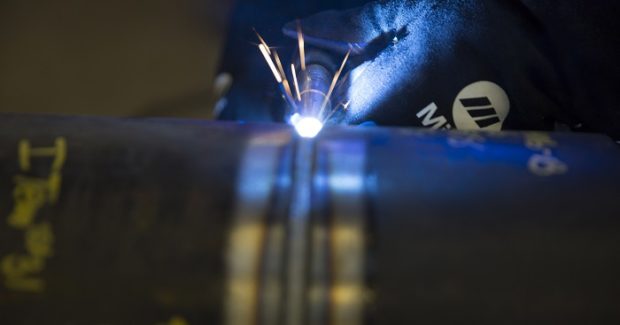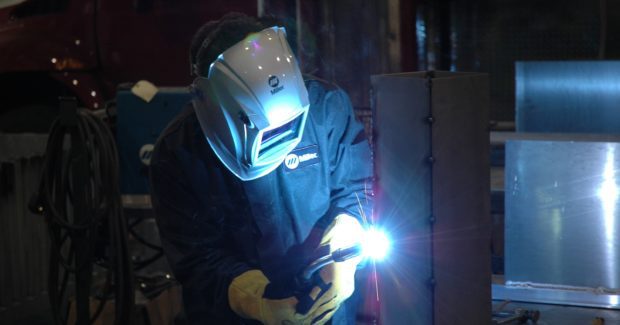Is Pulsed MIG Welding Right for Your Operation?
Do you need faster travel speeds, reduced spatter levels and improved control over arc starts to boost efficiencies or improve your MIG weld quality? With some training and a little practice, pulsed MIG welding can drive the improvements you need. Here are some factors to consider whether it is a good alternative for your operation.
Posted: June 28, 2018
Many fabrication operations have goals tied to improving productivity, part quality pulsed MIG weldingor profitability. While there are many steps that shops can take – from better welder training to implementing lean practices – a change in the welding process may be the right answer in an effort to reach these goals. In some applications, pulsed MIG welding (also called GMAW-P) is a process that can drive improvements and efficiency while helping operators of varying skill levels improve weld quality. Whether you’re changing over to pulsed MIG from a spray process, standard MIG or a short-circuit transfer process, it’s typically a smooth transition with a shorter-than-expected learning curve for welders. And though pulsed MIG typically has a higher upfront cost, the long-term benefits of the process can deliver a solid return on investment. In considering whether pulsed MIG is a good alternative to constant voltage (CV) MIG welding in your operation, think about these key factors:
HOW DOES PULSED MIG WELDING WORK?
Pulsed MIG is a modified spray transfer process using a power source that switches between a high peak current or voltage and a low background current or voltage between 30 times to 400 times per second. As this switch happens, the peak current pinches off a droplet of wire and propels it to the weld joint. At the same time, the background current maintains the arc but produces a low heat input that prevents metal transfer from occurring, allowing the weld puddle to freeze slightly and help prevent burn-through. This differs from a traditional spray transfer process, which continuously transfers tiny droplets of molten metal into the weld joint. The lower heat input of pulsed MIG welding provides similar advantages to the TIG (GTAW) process, while also offering good penetration, depositions rates and fusion – characteristics associated with a traditional spray transfer process.
Applications that are prone to weld defects – such as lack of fusion or porosity or problems like burn-through, spatter or warping – are good candidates for pulsed MIG, which can be used to weld thick or thin materials. On thicker materials, the process can minimize downtime for part repositioning since it generates a cooler weld puddle than a traditional spray transfer process, making it usable in all positions. On thinner metals, pulsed MIG minimizes the risk of burn-through and warping thanks to the lower heat input. This heat control allows welders to use larger-diameter wire of up to 3/64 in for increased deposition rates and productivity.
ADVANTAGES OF PULSED MIG WELDING
So what are some of the key benefits offered by pulsed MIG welding that help operations save time and money?
- Easy setup is a key feature with modern pulsed welding power sources. There is an option to have one-knob control to help operators set the parameters they need so that they don’t have to be an expert to get a good arc.
- Reduced spatter generated by the pulsed MIG process means less time and money spent on grinding and post-weld cleanup for a positive impact on the bottom line.
- Excellent directional control over the weld pool makes it easier for new welders to learn the process and create welds with good bead appearance. Most pulsed waveforms also have built-in adaptive technology that allows welders with less experience to produce quality welds more consistently.
- Faster wire feed and travel speeds help increase productivity while reducing heat input and the risk of distortion and burn-through. This makes pulsed MIG a good option for welding materials like stainless steel that require lower heat input to maintain certain properties.
- Improved control over arc starts and stops helps reduce weld defects and improve bead appearance. The process provides higher energy when the arc is first initiated, which provides good fusion, and the energy is then reduced going into the weld to help prevent burn-through and give the operator more control over bead appearance. When stopping the arc, a pulsed MIG process with a crater function allows the welder to ramp down to cooler parameters to fill in the crater at the end, eliminating the potential for termination cracking that can occur when welding materials such as aluminum.
- Adjustable arc cone width, a feature available with some pulsed MIG power sources, helps prevent over-welding and poor fusion because the operator can tailor the bead profile to the application. Wider weld beads help improve tie-in on both sides of the joint, while narrower beads offer good fusion at the joint root.
GETTING RESULTS WITH PULSED MIG
Pulsed MIG welding provides faster travel speeds, reduced spatter levels and improved control over arc starts compared to CV MIG, making it a good option for fabricators that want to boost efficiencies or improve weld quality. With some training and a little practice, welders of all skill levels can master pulsed MIG welding and optimize productivity and efficiency with the process.
Subscribe to learn the latest in manufacturing.






